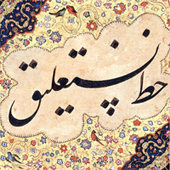
1108 (501 AH), A Thuluth inscription on Chehel Dokhtaran (forty girls) minaret in Isfahan. It is one of the first Thuluth inscriptions on minarets.

1122 Omar Khayyam (1048-1122) was dead in Neyshabur. He was a great mathematician, poet and astronomer, who performed the mathematical calculations to reform the Persian calendar, one of the most accurate calendars in the world and still in use to this day.

1114: The Ribat-i Sharaf (or Robat-e Sharaf) was built around this year. This huge monument is a caravanserai, or rest place for travellers in northeast Iran between Merv and Nishapur. The building looks like a fortified rectangle from the exterior. The courtyard and four Iwan floor plans are that of the traditional Standard Iranian Masjid. The walls and the pishtaq, the entranceway inside an iwan, are decorated with various elegance Kufic and Thuluth inscriptions in different styles as well as vegetal and geometric patterning that function to provide a good example of the "Textile Metaphor" seen in Middle Eastern architecture of this era. The caravanserai consisted of two inter-related four Iwan planned courtyards, famous for owning some of the most diverse and beautiful brick decorations in Iranian architecture.

1127 Kalan Minaret in Bukhara built. It is a tapering cylinder more than 51m high. The entire surface of the shaft is covered with broad bands of decorative brickwork, interspaced with bands of inscription by two lines of Kufic and Thuluth; the geometric designs within each band are different from those of the next.

1152 Mausoleum of Sanjar in Merv completed. The mausoleum is the largest and most spectacular Seljuk mausoleum to have survived to the present day. Built entirely of brick, it consists of a soaring dome some 14m in height, which rests upon an octagonal drum; this in turn sits upon a square chamber, the walls of which are particularly thick and unbroken by any major decorative scheme. There is an elegant Naskh inscription on the tombstone in the Mausoleum of Sultan Sanjar.

1169 Ayyubid Dynasty (1169-1260) founded in Cairo. Following the death of the last Fatimid Caliph in 1169, the Ayyubid dynasty was founded by Salah al-Din (Saladin). After consolidating his position, Saladin attacked the Crusader kingdoms, recapturing Jerusalem in 1187.

1191 (587 A.H.) the inscription of the inner Eastern gateway of the Quwwat ul Islam Mosque (meaning 'Might of Islam') in Delhi was written by pure Naskh. The language of this inscription is Persian and it is interesting to know that Persian appears to be used for epigraphic purposes in India much earlier than Iran. The Masjid was built immediately after the Ghurid conquest and is the earliest significant Islamic monument to have survived on the subcontinent. Columns reused from Hindu and Jain temples surround the courtyard, with most of the figural sculpture removed, and low Hindu domes stand over the qibla aisle. In 1198 a richly decorated screen wall of pointed arches was added on the courtyard side of the prayer hall.

1192: Ghiyath al-Din Muhammad of Ghur defeats the Rajput Prithvi Raj and conquers Delhi. What come him to power the Delhi Sultanate period (1192 - 1526 C.E./588 to 932 A.H.) started. It was shared by several dynasties. Five dynasties, one after another, occupied the throne of Delhi. There is a rare specimen of calligraphy during Bahri Mamluks or Slave Kings (1206-1288 C.E.) The styles of calligraphy as seen in the inscriptions of the above Sultans reached their culmination in the Khalji period (1288-1321 C.E.). Then the latter half of the Tughlaq period (1321-1414 C.E.) saw the appearance of some new styles. The reign of the Sayyid dynasty (1414-1450 C.E.) was very brief and there seems to have been no new development in the field of calligraphy during that period. But the calligraphers of the Lodi period (1451-1526 C.E.) appear to have shown some new styles of calligraphy. Regional dynasties, which at time accepted the power of Delhi, held sway in Sindh, Gujarat, Malwa, Gulbarga, Bidar, Jaunpur, Bengal, Bijapur, Golkonda and other provinces.

1193: The Qutb Minar construction commenced under the orders of India's first Muslim ruler Qutb-ud-din Aibak, and the topmost storey of the minaret was completed in 1386 by Firuz Shah Tughluq. This huge minaret was built soon after the Ghurid conquest of Delhi. It is ribbed and surrounded by decorative bands and splendour calligraphic inscriptions in carved stone. This building is notable for being one of the earliest and most prominent examples of Indo-Islamic architecture and masterpieces of its inscriptions.

1199: The Arhai Din Ka Jhonpra, Masjid in Ajmer, Rajasthan is a masterpiece of Indo-Islamic architecture a Masjid which stands in ruins today, was built by Mohammed Ghori in two-and-a-half days on the outskirts of Ajmer. A Sanskrit college, motifs and Islamic calligraphy adorn its facade. There is a masterpiece of calligraphic inscription on the central Mihrab of this Masjid by elegance Naskh. This inscription is pure elegant Naskh and done here on a carefully prepared floriated background. The Kufic and Jalil style inscription of historical interest was carved on the West wall of Arha’i-Din-ka-Jhonpra at Ajmer same as Quwwat ul-Islam Masjid’s inscriptions in 1199.

